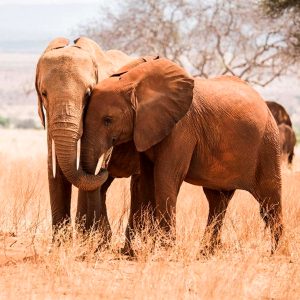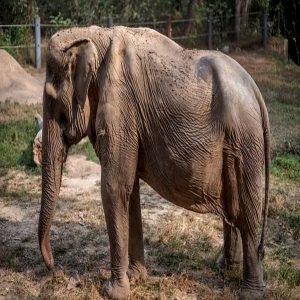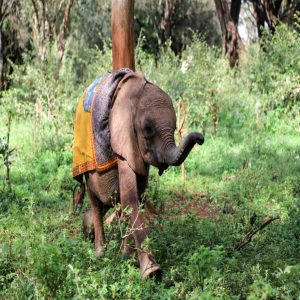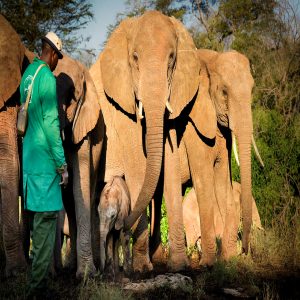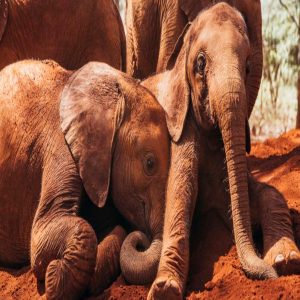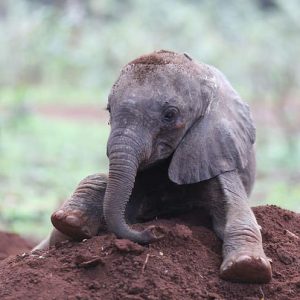Tucked between the majestic Chyulu Hills and the sprawling Amboseli ecosystem lies a hidden gem, the Kibwezi Forest.
It’s a unique and magical place in Kenya, boasting the rare distinction of being one of the last surviving groundwater forests in the country, with its lifeblood, the Umani Springs, breathing vitality into its lush existence.

Here, a group of 14 orphaned elephants thrives, having triumphed over adversity in their journey to call this emerald haven their home, framed by the captivating beauty of the Chyulu Hills.
The Kibwezi Forest nurtures these orphaned elephants, offering a serene backdrop for their rehabilitation.

The Umani Springs Reintegration Unit, our third site devoted to this noble cause, caters explicitly to this small yet extraordinary herd.
These elephants often face physical challenges, necessitating a slower and more gentle approach to recovery.
As the dawn’s first light filters through the forest’s foliage, the orphaned elephants rouse from their slumber.

The independent ones, affectionately known as “nightclubbers,” eagerly wait outside the gates to greet their companions.
Simultaneously, the dependent orphans, who have already enjoyed their morning milk, are primed to begin their day.
All the elephants gather near the fences, relishing lucerne before exploring the Kibwezi Forest.

Murera and Sonje, the matriarchs with lifelong mobility issues, utilize this time for elephant yoga and stretching before commencing their daily adventures.
The Keepers diligently prepare the compound while the orphans revel in the outdoors. This involves cleaning the elephants’ stockades, as cleanliness isn’t precisely an elephant’s forte. They restock the lucerne and get ready for the next milk feeding.
In about an hour, the order is restored as the orphans grow restless, signaling their readiness to venture into the Kibwezi Forest.

The Kibwezi Forest is not only a sanctuary for elephants but also a haven for diverse wildlife, introducing the orphans to a world of new friends during their daily escapades.
Thanks to their evening forays, the herd has forged bonds with other creatures, even capturing the attention of bull elephants.
Encounter with butterflies, terrapins, and bushbucks is a regular affair. Lima Lima, the self-appointed protector of the Keepers, remains vigilant, ever ready to alert in the face of potential danger.

Umani boasts an extraordinary variety of butterflies, some exclusive to this forest. Alongside the vibrant forest ecosystem, Umani Springs Headquarters bustles with activity.
It takes a dedicated team with diverse skills to oversee ambitious conservation projects within the Kibwezi Forest.
The canteen sustains the many team members who go throughout the day.

Nearby, a tree nursery receives meticulous care, nurturing thousands of indigenous seedlings.
Periodically, community tree planting events are conducted in areas ravaged by deforestation, ensuring the forest’s future.
Amidst this, Joi, the shy bushbuck orphan, often enjoys playful moments among the rows of plants, sneaking a bite when she thinks no one is watching.
The Kibwezi Forest plays a crucial role in our Saving Habitats initiative. When acquired from the Kenya Forest Service in 2008, the forest was already scarred by illegal hunting, logging, charcoal production, and domesticated animal intrusions.

Today, it is a testament to successful conservation methods involving local communities. Nonetheless, preserving this progress demands ongoing and coordinated efforts.
Our teams regularly patrol the forest and surrounding fences, safeguarding it from all sides, except where it meets Chyulu National Park.
An electrified fence is a vital boundary between the forest’s wildlife and nearby human settlements.

Our Anti-Poaching Units keep a watchful eye, ensuring the area remains untouched by illegal activities.
Three dedicated Sheldrick Wildlife Trust (SWT) teams join forces to protect the forests and Chyulu Hills ecosystem from harm.
Comprising passionate wildlife conservation professionals, they tirelessly guard against poaching and habitat destruction, preserving the area’s natural beauty and rich biodiversity.

Their collective endeavors ensure the forest and hills stay a wildlife sanctuary and maintain their thriving habitats.
The Umani Springs Lodge staff ensures everything is in perfect order for their guests. This lodge, nestled in a remarkable location, offers visitors the opportunity to witness the enchantment of the Kibwezi Forest while directly supporting its conservation.
Forest antelopes graze leisurely on the lawn, and vervet monkeys frolic with their young.

Even wild animals find solace here, as a crocodile sunbathes by the pond, surrounded by terrapins and bullfrogs. Bushbucks, too, make themselves at home on the lodge’s lawn.
The forest provides delightful waterholes, offering the elephants endless amusement. Visitors can partake in the elephants’ mud bath and milk feeding as our chef prepares lunch.
Luggard, in particular, relishes this time with his caretakers Murera, Sonje, and Lima Lima, enjoying a gentle dusting of soil before a sunny nap. During this break, the Keepers also get some rest, dining beneath the shade of a tree.

In the afternoon, the orphans stroll back to their sanctuary through the forest’s shaded groves and sparkling springs.
Each orphan can choose their sleeping arrangements, whether staying in the forest to interact with wild animals or returning to the sheltered fences equipped with freshly cut branches for a bedtime snack.
They are never alone; Keepers on night duty stay in an elevated tent within the lion-proof compound, ready to assist if needed.

While nights are generally peaceful, the occasional drama unfolds, like a leopard feasting in a nearby acacia tree.
Yet, the Keepers reassure the orphans and restore serenity with comforting words.
Umani Springs is a tranquil refuge beneath the canopy of the Kibwezi Forest. It offers solace to orphaned animals who’ve endured physical setbacks and traumatic experiences.

It’s a testament to the resilience of conservation, a reminder that with determination and vision, hope can be kindled.
The soothing sounds of bubbling springs and the rustling of wildlife through the trees provide a healing environment for these animals to rewrite their tragic histories and embrace their place in Kenya’s remarkable Kibwezi Forest ecosystem.
